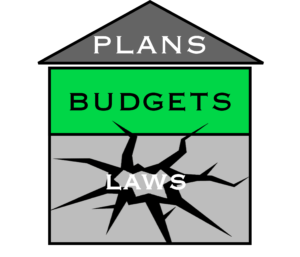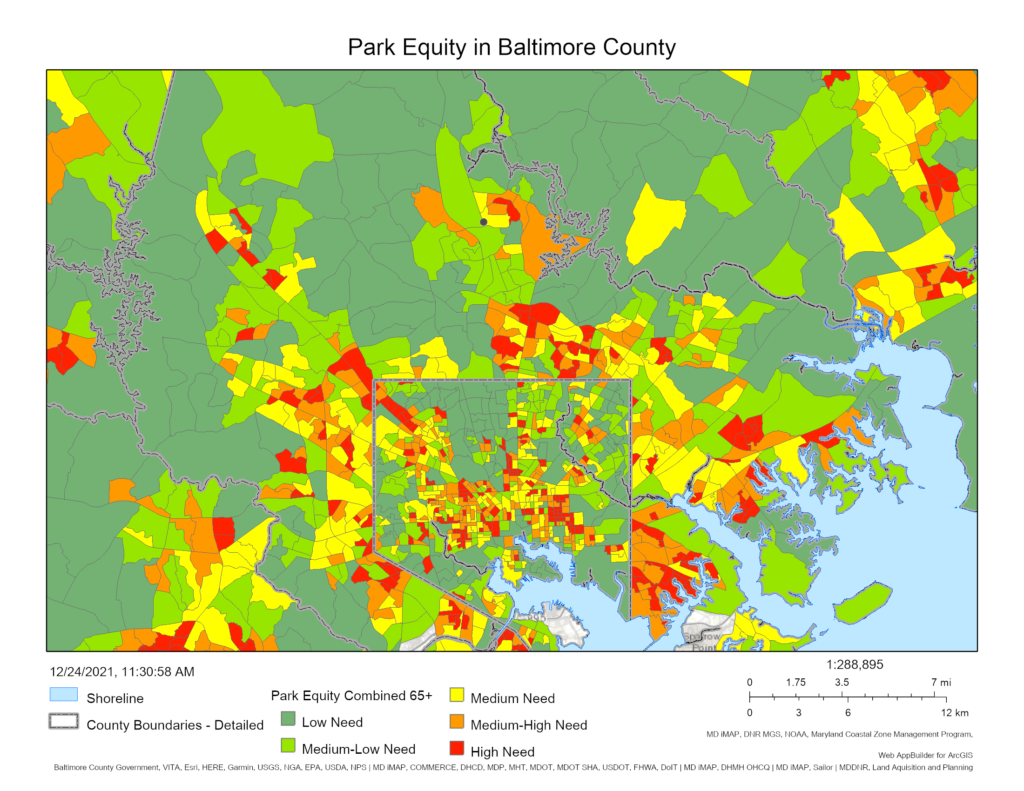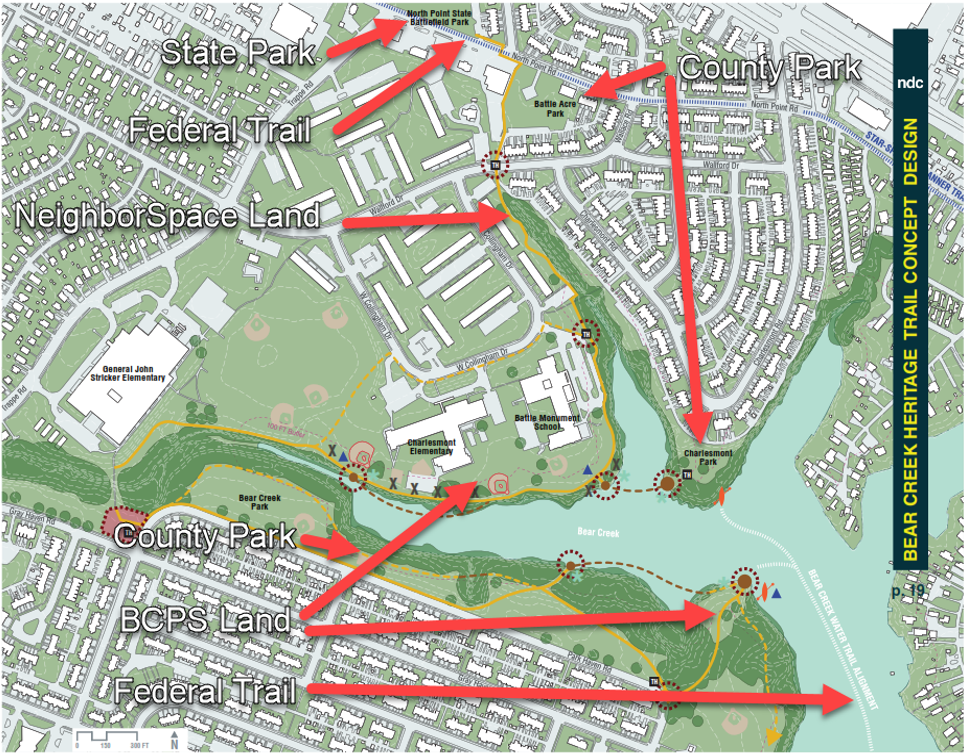
A. THE CHALLENGES
You know the challenges:
- Most of us lack access to adequate open space. 65 percent of residences inside the URDL lack access to adequate open space within a five-minute walk.
- The open space that does exist is inequitably distributed. The Maryland Park Equity Mapper shows many areas of inequity, especially on the west side of the County.
- We can’t walk anywhere. The average Walk Score in the inner suburbs is 41 (car dependent) on a scale that goes from 0 (car dependent) to 100 (walker’s paradise).
- We have few open space plans. Baltimore County is the only urbanized jurisdiction in metropolitan Baltimore without a green infrastructure plan. The last Parks and Recreation Master Plan dates to the 1950s.
- We haven’t previously budgeted to address inequity. That’s essential because open space fees collected in one area cannot be used to address inequities in another area under federal law.
- The Adequate Public Facilities Ordinance on open space is unenforced as such and ill-suited to its intended purpose. The County allows developers to meet a public open space requirement by setting aside publicly inaccessible, private land. The fees are insufficient to address the open space needs that new development creates. And there is no mandate that fees collected or land dedicated further goals in the Master Plan and related open space plans.
We should have laws that support our open space budget and plans. We should also have a budget that supports our plans. But our open space house is not in order. The foundation on which it rests, the law, is riddled with cracks. Other aspects of the structure are also rickety, as noted above. Such a house will not stand for long. What can be done?
space house is not in order. The foundation on which it rests, the law, is riddled with cracks. Other aspects of the structure are also rickety, as noted above. Such a house will not stand for long. What can be done?
B. THE SOLUTION: GETTING OUR OPEN SPACE HOUSE IN ORDER
Clearly we need to get our open space house in order. There are signs, noted below, that the County is on a path to addressing many of the challenges enumerated above. But while the County Executive wields substantial authority over plans and budgets, he, alone, cannot change the law. That will require people like you and me to demand change from the County Council. In that spirit, here are some thoughts on getting our open space house in order in the context of preparing for the upcoming County budget meetings to be held by the County Executive and Members of the County Council according to the schedule specified here. The ideas include (1) fixing the foundation by amending the open space law; (2) planning to address inequity and create green networks; and (3) budgeting to fund the plans. Let me elaborate.
-
Amend and Enforce the Open Space Law So That It Supports the Capital Budget and County Open Space Plans
The County Executive is to be commended for organizing a Work Group to study and make recommendations for changing the open space law. NeighborSpace has advocated for six overarching changes to the law so that it functions as a tool for creating more publicly accessible, networked open space in support of County plans and budgets. They include: (a) Ensuring that land and fee dedications are exclusively for public open space; (b) Requiring that those dedications align with County open space plans; (c) Making sure open space needs and fees assessed to address them are in balance; (d) Strictly limiting the extent to which amenities are allowed to offset fees; (e) Ensuring that all types of development, including commercial projects, contribute public open space or a pay a fee; and (f) Implementing a regulation that builds on an amended ordinance. Allow me to elaborate.
a. Lands Dedicated and Fees Collected Must be Exclusively for Public Open Space
The County allows developers to satisfy a legal requirement to offset the impacts of development on public parks with publicly inaccessible, private land. This legal mandate is in the same section of the code as provisions that require developers to offset the impacts of development on roads, schools, and sewers. Those mandates are not met with private roads, private schools, or private sewers. Why should open space be treated differently? In addition, a study conducted by NeighborSpace of similar laws from other inner-suburban jurisdictions around the country did not identify another county that permits an adequate public facilities ordinance to be satisfied with publicly inaccessible, private land - NOT ONE!
b. Land Dedicated and Fees Collected Must Further Goals in County Plans
NeighborSpace research on the impact of residential development on the adequacy of open space in the County revealed one case where a fee of $340,000 (more money than the County collected in open space fees in several years running) was assessed and used to pay for things like a polygon shade structure, picnic tables, and grills in a neighboring community, doing nothing to advance overarching open space goals. The law must be amended to require that land dedications and fee payments advance open space goals in County plans, supporting rather than hurting the County’s capital budget.
c. In Setting Fees, Open Space Needs and Fees Must be in Balance
Federal law requires that there be a balance between the open space need caused by a development project and the fee or dedication requirement placed on the developer. As practical matter, this requires an assessment of the existing level of park service within the vicinity of the project and establishing a fee and land dedication requirement that is commensurate with purchasing and improving land in order to meet that existing level of service. Currently we have one standard establishing a level of service county-wide that is unrelated to any need we have been able to identify. Worse, the fees are currently insufficient to meet needs anywhere because they do not account for the cost of both buying and improving land with parks. So, right now, every new development that is approved fails to fully address its impact on public open space needs, further eroding quality of life incrementally in our communities as each new housing project is completed.
d. Fee Offsets Must be Strictly Limited
Currently, the provision of “public amenities” can offset the payment of fees or the provision of open space. I’ve been called to testify in cases where this provision enabled developers to meet the open space requirement by resurfacing trails and buying new backboards and nets for basketball courts in existing public parks. The problem here is that these expenditures do NOTHING to minimize the impact of growth on these facilities. They’re not adding new trails; rather, they’re resurfacing them. They’re not adding new courts; rather they’re repairing them. Recreation and Parks should be budgeting for the maintenance of its facilities. The open space fees should be producing new public open space and the only amenity supported by a fee should be one that is the result of creating a new public park or trail to serve growth.
e. All Types of Development Must Contribute
Currently, only major subdivisions, i.e. residential projects involving more than three homes, must comply with the open space law. Commercial projects are exempt as are minor subdivisions, i.e., residential projects of three homes or less.
As part of an ongoing County Work Group on open space standards, NeighborSpace studied the open space ordinances of inner-suburban jurisdictions across the country. While not all required all types of development to contribute toward the provision of public open space, those that did had robust green networks and much higher rankings on AARP’s livability index, which measures a community’s quality of life. Inner suburbs around Washington, D.C. and St. Paul, MN require all types of projects to pay, have vibrant green networks as revealed in this presentation, and are at the top of the AARP rankings, shown below. Baltimore County, on the other hand, ranks near the bottom.

f. The Open Space Manual Must be Updated to Expand on the Ordinance and Advance Key Policies
The current manual should act like a regulation to implement the open space ordinance, expanding on it, advancing open space plans and policies, and addressing contemporary open space needs. It fails to do so because it has not been revised in nearly 22 years and is not based on the law, current insights of active lifestyle health impacts, or the effect of public open space on quality of life in communities.
-
Develop New Open Space Plans That Address Inequity and the Creation of a Vibrant, Green Network
Many of us have been engaged in recent discussions around the 2030 County Master Plan, which is the overarching blue print for how we will order the built environment over the next ten years. That plan needs to include development of a Recreation and Parks Master Plan, something for which the current Director of Recreation and Parks has been advocating. It also needs to go beyond analysis available from Maryland’s Park Equity Mapper, shown below, to identify inequities in the distribution of parks and trails in the County and specify strategies and a timeline for addressing them.

Beyond that, the Master Plan needs to include development of a green network plan as a priority to improve walkability and the coordination of investments in green infrastructure. What exactly is a green network?
A good definition can be found in the Green Network Plan for Baltimore City, which defines a green network as a holistic system of nodes, defined as open, green spaces for people and nature to meet, connected by corridors, defined as linear passageways for people and wildlife to travel safely and comfortably. (Baltimore City Green Network Plan, Executive Summary, p. 3). A green network provides connectivity not just to parks but also to important institutional, commercial, and cultural hubs, as shown in the diagram below. And while trails and wildlife corridors are important elements of connectivity in a green network, sidewalks, streets, blueways, bike lanes, and utility corridors are also important as shown in the diagram below:

-
Budget for Consultants to Create New Open Space Plans and for Projects that Address Inequity and Connectivity
Budgets are all about setting priorities. We are hopeful that the County Executive’s next budget will include funding to hire consultants to develop the plans described above. With good plans focusing our attention on addressing inequities and places where deficits are highest, we can turn our attention to budgeting for parks and trails to address these challenges.
One unfinished project with an equity focus is Powhatan Park in Lochearn. The map below from the State’s Park Equity Mapper shows just how important Powhatan Park is to addressing inequity in the distribution of open space in Lochearn, especially for kids. NeighborSpace has raised over $60,000 for new rain gardens, pollinator meadows, and vegetated swales on a site that has been devastated by stormwater challenges. But those grants will not fund the $23,000 cost associated with improving a much-needed trail that provides connectivity to a neighboring elementary school and to two roads into the community.

Another place where both park equity and access to open space are low is Dundalk, the site of the Bear Creek Heritage Trail. This trail will help to interpret the Battle of North Point during the War of 1812. It will also help to connect two federal trails, four public schools, three County parks, and one State park, providing an excellent example of a green network, as shown in the diagram below. NeighborSpace and its local partners have raised $145,000 to develop concept and phasing plans for the project. Phases 1 and 2 of the project involve improving connectivity to and through a County Park, Battle Acre, that is part of the trail project at an estimated cost of $250,000.

C. HOW YOU CAN HELP
- Share Your Thoughts on Open Space Priorities with the County Executive via email at townhall@baltimorecountymd.gov. Click here for a draft of an email that we have prepared.
- Share Your Thoughts on Open Space Priorities with Your Council Representative. Click here for your council rep's email address and a draft of an email that we have prepared.
- Sign up to Testify on Open Space Priorities at the Virtual Budget Town Hall Meeting in Your District by emailing townhall@baltimorecountymd.gov with the following information:
-
- Your district and the area where you live (Example: District 2, Owings Mills)
- Name
- Phone number
- Email address
- Budget priority you will be speaking on (e.g., open space)
After the County Executive’s budget presentation, residents who have signed up are given 90 seconds to speak or ask a question on their budget idea or priority. The hearings are online (click here for the login details & updates) on the following dates:
-
- Council 1: Wednesday, March 16, Time: TBD
- Council 2: Tuesday, Jan. 25, 6:30- 8:00 PM
- Council 3: Wednesday, Feb. 2, 6:30-8:00 PM
- Council 4: Thursday, March 24, Time: TBD
- Council 5: Thursday, Feb. 10, 6:30-8:00 PM
- Council 6: Wednesday, March 9, Time: TBD
- Council 7: Wednesday, Feb. 23, Time: TBD
Pingback: Respected Think Tank Urges Reform of County Open Space Laws – NeighborSpace of Baltimore County